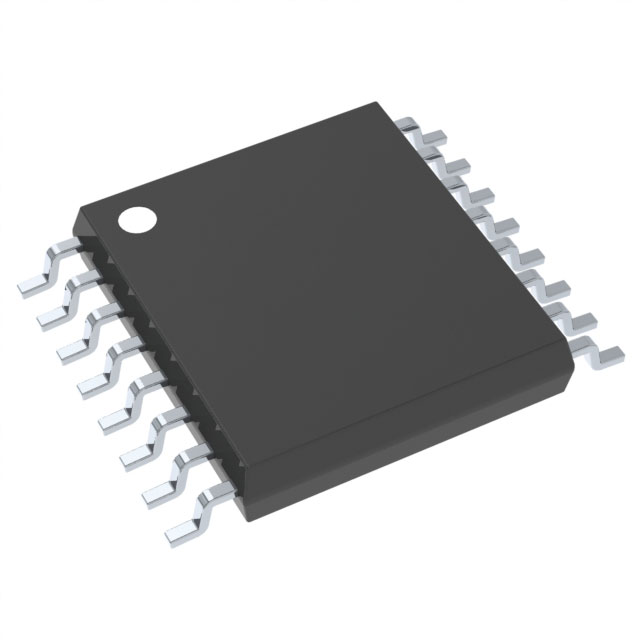Viz Specifikace pro podrobnosti o produktu.

ADS7253IPWR
Basic Information Overview
- Category: Integrated Circuit (IC)
- Use: Analog-to-Digital Converter (ADC)
- Characteristics: High-speed, low-power, 12-bit resolution
- Package: TSSOP-16
- Essence: Converts analog signals into digital data
- Packaging/Quantity: Tape and reel, 2500 units per reel
Specifications
- Resolution: 12 bits
- Sampling Rate: Up to 1 MSPS (Mega Samples Per Second)
- Input Voltage Range: 0V to Vref
- Power Supply Voltage: 2.7V to 5.5V
- Power Consumption: 1.6 mW at 1 MSPS
- Operating Temperature Range: -40°C to +125°C
Detailed Pin Configuration
The ADS7253IPWR has a total of 16 pins arranged as follows:
Pin 1: VIN1+ (Positive input for Channel 1)
Pin 2: VIN1- (Negative input for Channel 1)
Pin 3: AGND (Analog ground)
Pin 4: VREF (Reference voltage)
Pin 5: VIN2+ (Positive input for Channel 2)
Pin 6: VIN2- (Negative input for Channel 2)
Pin 7: CLK (Clock input)
Pin 8: CS (Chip select)
Pin 9: DOUT (Digital output)
Pin 10: DGND (Digital ground)
Pin 11: DIN (Digital input)
Pin 12: PDWN (Power down)
Pin 13: REFSEL (Reference voltage selection)
Pin 14: NC (No connection)
Pin 15: AVDD (Analog power supply)
Pin 16: DVDD (Digital power supply)
Functional Features
- Dual-channel ADC with simultaneous sampling capability
- High-speed conversion with low power consumption
- Wide input voltage range and reference voltage selection
- SPI-compatible serial interface for easy integration
- Power-down mode for reduced power consumption during idle periods
Advantages and Disadvantages
Advantages: - High-speed conversion enables real-time data acquisition - Low-power consumption extends battery life in portable applications - Dual-channel simultaneous sampling allows for precise measurements - Wide input voltage range accommodates various signal levels
Disadvantages: - Limited resolution compared to higher-bit ADCs - Requires an external clock source for operation - TSSOP package may be challenging for hand soldering
Working Principles
The ADS7253IPWR is an analog-to-digital converter that converts continuous analog signals into discrete digital data. It utilizes a dual-channel architecture, allowing simultaneous sampling of two input channels. The analog input signals are amplified, filtered, and then converted into digital format using a successive approximation register (SAR) technique. The converted digital data is then output through the serial interface.
Detailed Application Field Plans
The ADS7253IPWR is commonly used in applications that require high-speed and accurate analog-to-digital conversion. Some potential application fields include: 1. Data Acquisition Systems: Used to capture and digitize analog signals from sensors, transducers, or other measurement devices. 2. Industrial Automation: Enables precise monitoring and control of industrial processes by converting analog sensor readings into digital data. 3. Medical Instruments: Used in medical devices such as patient monitors and diagnostic equipment to convert physiological signals into digital format for analysis. 4. Communications Equipment: Enables the digitization of analog signals in communication systems, such as wireless base stations and network analyzers. 5. Test and Measurement Instruments: Used in oscilloscopes, spectrum analyzers, and other test equipment to capture and analyze analog signals.
Detailed and Complete Alternative Models
Some alternative models to the ADS7253IPWR include: - ADS7229: 12-bit, dual-channel ADC with lower power consumption - ADS7864: 12-bit, quad-channel ADC with higher resolution and lower sampling rate - ADS8864: 16-bit, dual-channel ADC with higher resolution and lower power consumption
These alternative models offer different trade-offs in terms of resolution, channel count, power consumption, and other features, allowing designers to choose the most suitable option for their specific application requirements.
Word count: 526 words
Seznam 10 běžných otázek a odpovědí souvisejících s aplikací ADS7253IPWR v technických řešeních
Sure! Here are 10 common questions and answers related to the application of ADS7253IPWR in technical solutions:
Q: What is the ADS7253IPWR? A: The ADS7253IPWR is a high-speed, low-power, 12-bit analog-to-digital converter (ADC) designed for various applications.
Q: What is the maximum sampling rate of the ADS7253IPWR? A: The ADS7253IPWR has a maximum sampling rate of 40 megasamples per second (MSPS).
Q: What is the input voltage range of the ADS7253IPWR? A: The ADS7253IPWR has a differential input voltage range of ±2.5V.
Q: Can the ADS7253IPWR operate with a single power supply? A: Yes, the ADS7253IPWR can operate with a single power supply ranging from 2.7V to 3.6V.
Q: Does the ADS7253IPWR have built-in digital filters? A: No, the ADS7253IPWR does not have built-in digital filters. It provides raw ADC output data.
Q: What is the interface used to communicate with the ADS7253IPWR? A: The ADS7253IPWR uses a serial peripheral interface (SPI) for communication with microcontrollers or other devices.
Q: Can the ADS7253IPWR be used in industrial applications? A: Yes, the ADS7253IPWR is suitable for industrial applications due to its high-speed and low-power characteristics.
Q: Is the ADS7253IPWR compatible with both 3.3V and 5V logic levels? A: Yes, the ADS7253IPWR is compatible with both 3.3V and 5V logic levels, making it versatile for different systems.
Q: What is the typical power consumption of the ADS7253IPWR? A: The typical power consumption of the ADS7253IPWR is around 20mW at a 40 MSPS sampling rate.
Q: Can the ADS7253IPWR be used in battery-powered applications? A: Yes, the low-power characteristics of the ADS7253IPWR make it suitable for battery-powered applications where power efficiency is crucial.
Please note that these answers are general and may vary depending on specific application requirements.

